Sold Ceramics
Sold Japanese Imari 1690-1800
'Gold' Imari
Page 1
A group that seems to have been especially favoured in The Netherlands, traditionally called 'Gold Imari', dates to the early 18th century. These wares are painted in gold only, in gold and iron-red, or in gold and red with a few touches of green, aubergine and black. 'Gold Imari' is relatively well represented in collections in the northern parts of The Netherlands but which occurs less often in old English and German collections
From about 1700 the gold often has a pink-violet hue ('pink lustre'), which is clearly visible on the white porcelain background when the gold is very thin or has been rubbed off. It seems that the Japanese enamellers used a different process to the Chinese, because Chinese pieces do not have this pink violet hue. (Jörg 2003/1, pp.92-93)
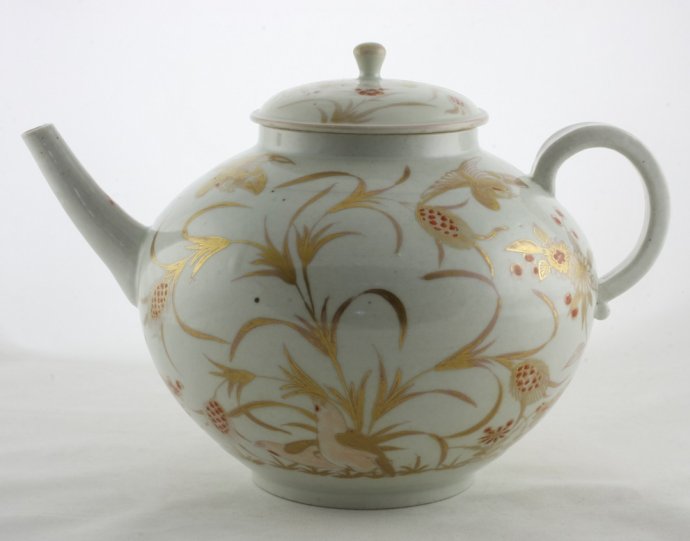
Sold Ceramics - Sold Japanese Imari 1690-1800 - 'Gold' Imari - Page 1
Object 2010668
Teapot or hot water pot
Japan
1700-1720
Height with cover 178 mm (7.01 inch), diameter handle to spout 251 mm (9.88 inch), diameter of mouthrim 80 mm (3.15 inch), diameter of footring 88 mm (3.47 inch)
Teapot or hot water pot on footring, curved handle and a straight spout. Domed lid with round knob. 'Gold' Imari, decorated in gold, iron-red and a pink-gold wash with three groups of flowering plants, each with a pair of birds, namely millet and quail, carnation and crested grouse and double camellia with partridge. Between each group a bird in flight. On the handle a floret between scrolls and on the cover three groups of flowering plants with three birds in flight.
In the collection of Oriental Ceramics of the Groninger Museum is a identically decorated teaset that consists of an identical teapot / hot water pot, six cups and saucers for tea or coffee, six chocolate cups with covers and saucers, a bowl with an overturned rim that might have been a sugar bowl and a ewer which may have been used as a milk jug but could also have been a condiment jug in a dinner set with the same design of which parts are also in the Groninger Museum. The set entered the Groninger Museum in 1899 as a bequest of the local collector, Mr. Mello Backer. Some sherds of similar wares have been excavated at Deshima. (Jörg 2003/1, p.201)
For the identically decorated teaset (including the large teapot / hot water pot) in the collection of Oriental ceramics of the Groninger Museum, please see:
Condition: A restored handle.
References:
Jörg & Van Campen 1997, cat. 237
Price: Sold.
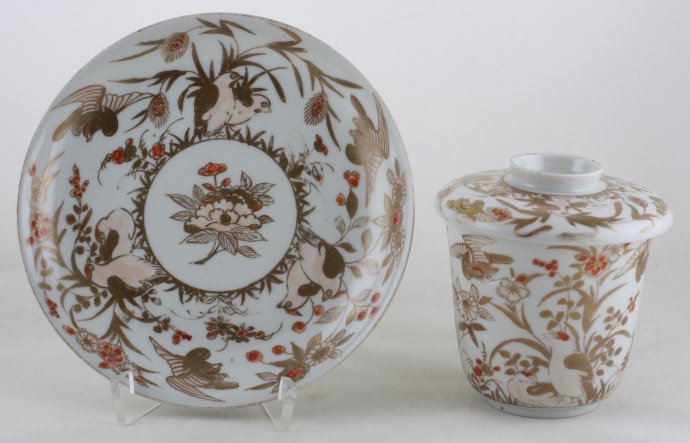
Sold Ceramics - Sold Japanese Imari 1690-1800 - 'Gold' Imari - Page 1
Object 2012425
Chocolate cup with cover and saucer
Japan
1700-1720
Height saucer 23 mm ( 0.91 inch), diameter of rim 145 mm (5.71 inch), diameter of footring 73 mm (2.87 inch), weight 200 grams (7.05 ounce (oz.))
Height cup 74 mm (2.91 inch), diameter of rim 79 mm (3.11 inch), diameter of footring 39 mm (1.54 inch), weight 113 grams (3.99 ounce (oz.))
Height cover 20 mm (0.79 inch), diameter 85 mm (3.35 inch), diameter of ring knob 30 mm (1.18 inch), weight 53 grams (1.87 ounce (oz.))
Tall chocolate cup with cover and saucer on footring, the cup with steep sides. Domed cover with ring knob. 'Gold' Imari, decorated in gold, iron-red and a light-pinkish gold wash with a spray of blossoming pomegranate in a central roundel surrounded by grasses and three groups of flowering plants each with a pair of birds, namely millet and quail, carnation and crested grouse, double camellia and partridge. In between each group a bird in flight. The rim with four panels containing sprays of peony, double magnolia, double chrysanthemum and double camellia. The reverse is undecorated. The cup and cover are decorated en suite.
A group that seems to have been especially favoured in The Netherlands, traditionally called 'Gold Imari', dates to the early 18th century. These wares are painted in gold only, in gold and iron-red, or in gold and red with a few touches of green, aubergine and black. 'Gold Imari' is relatively well represented in collections in the northern parts of The Netherlands but which occurs less often in old English and German collections
From about 1700 the gold often has a pink-violet hue ('pink lustre'), which is clearly visible on the white porcelain background when the gold is very thin or has been rubbed off. It seems that the Japanese enamellers used a different process to the Chinese, because Chinese pieces do not have this pink violet hue. (Jörg 2003/1, pp.92-93)
Tall cups with covers are usually called chocolate cups, although there is no firm proof they were used as such. However, English sale records of the early 18th century mention 'Japan chocolate cups' covers and saucers (Godden 1979), a description appropriate to this shape. Chocolate was a fashionable drink at the end of the 17th century, although it never became as popular as tea and coffee. It was served with a foamy milk top, which meant that the cups had to be tall. The cover kept the drink warm. Chocolate cups are relatively rare. (Jörg 2003/1, p.202)
In the collection of Oriental Ceramics of the Groninger Museum is a identically decorated teaset that consists of an identical teapot / hot water pot, six cups and saucers for tea or coffee, six chocolate cups with covers and saucers, a bowl with an overturned rim that might have been a sugar bowl and a ewer which may have been used as a milk jug but could also have been a condiment jug in a dinner set with the same design of which parts are also in the Groninger Museum. The set entered the Groninger Museum in 1899 as a bequest of the local collector, Mr. Mello Backer. Some sherds of similar wares have been excavated at Deshima. (Jörg 2003/1, p.201)
For the identically decorated teaset (including the large teapot / hot water pot) in the collection of Oriental ceramics of the Groninger Museum, please see:
- Fine & Curious. Japanese Export Porcelain in Dutch Collections, (C.J.A. Jörg, Hotei Publishing, Amsterdam, 2003), p.201, cat. 256.
- Chinese and Japanese porcelain for the Dutch Golden Age, (J. van Campen & T. Eliëns ed., Waanders Publishers in collaboration with Rijksmuseum Amsterdam, Gemeentemuseum Den Haag, Groninger Museum, Keramiekmuseum Princessehof Leeuwarden, Zwolle 2014), p.120, Fig. 9.
Condition: Wear to the decoration on the inside of the cover. A firing flaw to the saucer. A hairline to the cup and tree chips to the rim of the cover.
References:
Jörg & Van Campen 1997, cat. 237
Jörg 2003/1, pp.92-93, p.202 & cat. 124 & 256
Price: Sold.
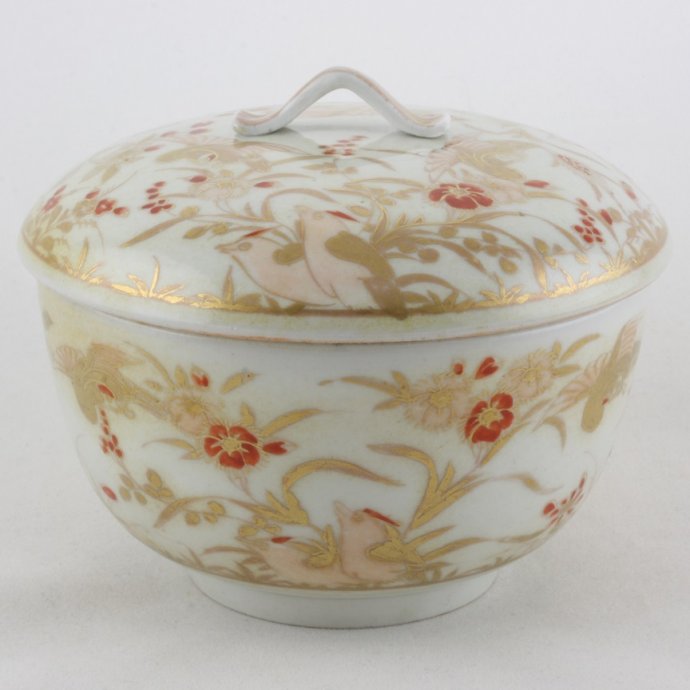
Sold Ceramics - Sold Japanese Imari 1690-1800 - 'Gold' Imari - Page 1
Object 2012345
Covered bowl
Japan
1700-1720
Height with cover 100 mm (3.94 inch), height without cover 63 mm (2.48 inch), diameter 111 mm (4.37 inch), diameter of footring 55 mm (2.17 inch), weight with cover 364 grams (12.84 ounce (oz.)), weight cover 155 grams (5.47 ounce (oz.))
Covered bowl on footring. Straight sides, domed cover with strap handle. 'Gold' Imari, decorated in gold, iron-red and a pink-gold wash with on the box three groups of flowering plants, each with a pair of birds, namely millet and quail, The cover is decorated en suite, the strap handle is decorated in gold.
A group that seems to have been especially favoured in The Netherlands, traditionally called 'Gold Imari', dates to the early 18th century. These wares are painted in gold only, in gold and iron-red, or in gold and red with a few touches of green, aubergine and black. 'Gold Imari' is relatively well represented in collections in the northern parts of The Netherlands but which occurs less often in old English and German collections
From about 1700 the gold often has a pink-violet hue ('pink lustre'), which is clearly visible on the white porcelain background when the gold is very thin or has been rubbed off. It seems that the Japanese enamellers used a different process to the Chinese, because Chinese pieces do not have this pink violet hue. (Jörg 2003/1, pp.92-93)
This covered bowl is a magnificent example of the 'gold' Imari group. No underglaze blue or other enamels are used, the light pinkish wash lending sufficient contrast to the brighter red and gold. Besides dinner services, covered jars, tea, coffee and chocolate sets, decorated in 'Gold' Imari with this design, also other utilitarian or luxury items, like this coverd bowl, were ordered after a Western model. These included cylindrical beer mugs, barbers' bowls, cuspidors and chamber-pots therefore this covered bowl can be considered a Japon de commande object. (Jörg 2003/1, p.164, cat. 188)
In the collection of Oriental Ceramics of the Groninger Museum is an identically decorated teaset that consists of an identical teapot / hot water pot, six cups and saucers for tea or coffee, six chocolate cups with covers and saucers, a bowl with an overturned rim that might have been a sugar bowl and a ewer which may have been used as a milk jug but could also have been a condiment jug in a dinner set with the same design of which parts are also in the Groninger Museum. The set entered the Groninger Museum in 1899 as a bequest of the local collector, Mr. Mello Backer. Some sherds of similar wares have been excavated at Deshima. (Jörg 2003/1, p.201 & p.213)
The quail, closely allied to the partridge, is an emblem of courage both in China and Japan, as it is highly esteemed as a fighting bird. On Japanese porcelain they are frequently depicted amidst autumn grasses under millet. This quail and millet design, symbolizing the autumn is especially common on Kakiemon, but is also found on ko Kutani, Imari and blue-and-white wares. It has been suggested that that particular form is copied from the work of the painter Tosa Mitsuoki (1607-1691), but it probably originated from Chinese Paintings of the Sung period. This motif has been copied on European porcelain, especially at Bow and Chelsea where it is used as a decoration on the so-called 'partridge plates' and also on Meissen Porcelain. (Arts 1983, pp.134-135)
The shape, most likely, derived from a European (silver) model, it was used as a small tureen. Jörg describes a bowl with cover on three low feet with a matching saucer this may indicate that originally the covered box also might have had a matching saucer. (Jörg 2003/1, p.110, cat. 113)
For identically decorated dishes decorated with the 'millet and quail' design, please see;
- The Voyage of Old-Imari Porcelains, (Kyushu Ceramic Museum, Arita 2000), pp.54-56, cat. 81-85
- Fine & Curious: Japanese Export Porcelain in Dutch Collections, (C.J.A. Jörg, Hotei Publishing, Amsterdam 2003), pp.115-116, cat. 123.
- Melk en Bloed. Exquisite porcelain from the Middle Kingdom, (D. Suebsman, Norden 2019), p.114, cat. 53.
For the identically decorated tea-set with the 'millet and quail' design in the collection of Oriental ceramics of the Groninger Museum, please see:
For a similarly decorated dish with the 'millet and quail' design, please see;
For other objects, for sale or sold, identically decorated with the 'millet and quail' design, please see;
-
Sold Ceramics - Sold Japanese 'Gold' Imari 1690-1800 - Object 2011745 & Object 2011746.
-
Sold Ceramics - Sold Japanese 'Gold' Imari 1690-1800 - Object 2011444.
-
Sold Ceramics - Sold Japanese 'Gold' Imari 1690-1800 - Object 2010574.
-
Sold Ceramics - Sold Japanese 'Gold' Imari 1690-1800 - Object 2010673.
Condition: Some wear to the golden decoration on the strap handle and a firing flaw to the cover.
References:
Jörg 2003/1, cat. 113, 116, 123 & 256
Price: Sold.
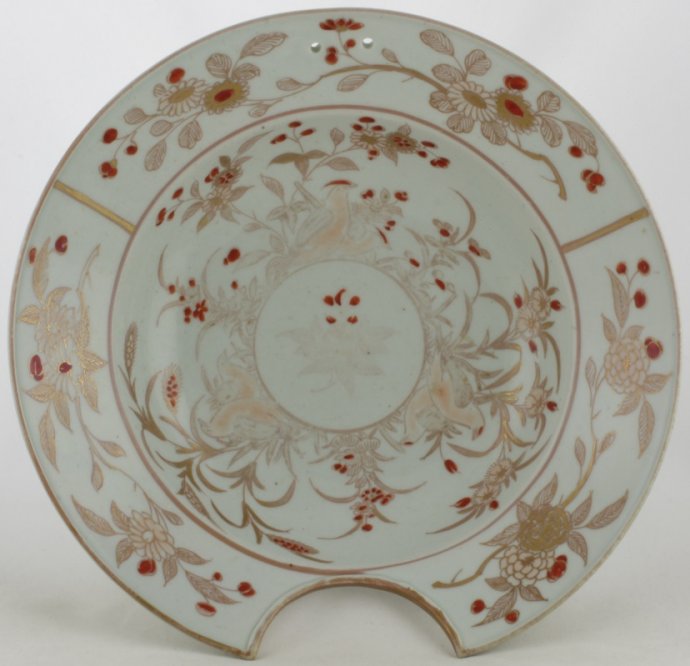
Sold Ceramics - Sold Japanese Imari 1690-1800 - 'Gold' Imari - Page 1
Object 2012036
Shaving bowl
Japan
1700-1730
Height 77 mm (3.03 inch), diameter of rim 280 mm (11.02 inch), diameter of footring 110 mm (4.33 inch), weight 1,054 grams (37.18 ounce (oz.))
Shaving bowl on footring with a spreading flat rim, in it a saved semi-circular section below and two small glazed holes opposite the cut-out section of the rim. On the base one single spur-mark. 'Gold' Imari, decorated in gold, iron-red and a light pinkish gold wash with a flowering peony spray in a central roundel surrounded by grasses and three groups of flowering plants each with a pair of birds, namely millet and quail, carnation and crested grouse and double camellia with partridge. On the rim sprays of peony, double magnolia and double camellia.
The quail was a popular motif and occurs on all kinds of Arita porcelain. As a fighting bird, it symbolises courage. Quail and millet indicate autumn. The quail was extensively copied on 18th-century porcelain. Some of the flowers and birds in this complex decoration are rather stylised, making identification somewhat difficult. Some sherds of similar wares have been excavated at Deshima. (Jörg & Van Campen 1997, p.213), (Jörg 2003/1, pp.115-116 & p.201)
This shaving bowl is a magnificent example of the 'gold' Imari group. No underglaze blue or other enamels are used, the light pinkish wash lending sufficient contrast to the brighter red and gold. In the collection of Oriental Ceramics of the Groninger Museum is an identically decorated teaset that consists of an identical teapot / hot water-pot, six cups and saucers for tea or coffee, six chocolate cups with covers and saucers, a bowl with an overturned rim that might have been a sugar bowl and an ewer which may have been used as a milk jug but could also have been a condiment jug in a dinner set with the same design of which parts are also in the Groninger Museum. The set entered the Groninger Museum in 1899 as a bequest of the local collector, Mr. Mello Backer. It is likely that this teaset was ordered together with the dinner set.
Besides dinner services, covered jars, tea, coffee and chocolate sets decorated in 'Gold' Imari with this design, also other utilitarian or luxury items were ordered after a Western model. These included cylindrical beer mugs, chamber-pots, cuspidors and shaving bowls therefore this shaving bowl can be considered a Japon de commande object. (Jörg 2003/1, p.164, cat. 188)
For other objects decorated with this design in 'gold' Imari, please see:
- Japanese porcelain. A collector's guide to general aspects and decorative motifs, (P.L.W. Arts, De Tijdstroom, Lochem, 1983), p.135, Plate 80.
- Imari-Porzellan am Hofe der Kaiserin Maria Theresia, exhibition catalogue (Hetjens-Museum, Düsseldorf, 2000), p.49, cat. 10.
- Fine & Curious. Japanese Export Porcelain in Dutch Collections, (C.J.A. Jörg, Hotei Publishing, Amsterdam, 2003), pp.115-116, cat. 123 & 200-201, cat. 256.
-
Sold Ceramics - Sold Japanese Imari 1690-1800 - 'Gold' Imari - Page 1 - Object 2010574.
-
Japanese Imari 1690-1800 - 'Gold' Imari - Page 1 - Object 2012034.
-
Sold Ceramics - Sold Japanese Imari 1690-1800 - 'Gold' Imari - Page 1 - Objects 2011745 & 2011746.
The first documentary evidence for scheerbeckens or shaving bowls is a 1662 invoice from the Director of the Deshima factory in Nagasaki regarding an order for 258 of these dishes for shipment to the Netherlands. After this point shaving dishes become a regular export item.
Shaving bowls were used by barbers and were indispensable in the Dutch household too. They were made of earthenware, pewter, copper and even silver. Beside their function as a shaving utensil, they had an alternative use, namely to let blood from a vein in the arm during blood-letting. This was a medical procedure thought to drain bad blood from the system, which was also performed by the barber/surgeon. In the seventeenth century, regulations were put in place in England to govern what barbers were permitted to do. Thus they became confined to bloodletting and treating external diseases. In Prussia the barbers' and the surgeons' guild joined in 1779, and it was said of great Prussian surgeons that they had risen "up from the barber's bowl”. Both purposes explain the semi-circular saving. The two holes in the rim are for a cord or string. A shaving basin with the actual silk string still attached was excavated in Amsterdam. The string was used to suspend it from the client's neck to catch lather and water during shaving, or to hang the bowl on the wall thus implying that owners also appreciated the bowl for its decorative value as well as its function. Shaving bowls can be seen hanging on the wall as such in some dollhouses.
Cornelis Troost, Arlequin toovenaar en barbier, 1738, Mauritshuis, The Hague, Netherlands, inv. nr. 184. In spite of the satirical intent, the painting reflects actual usage.
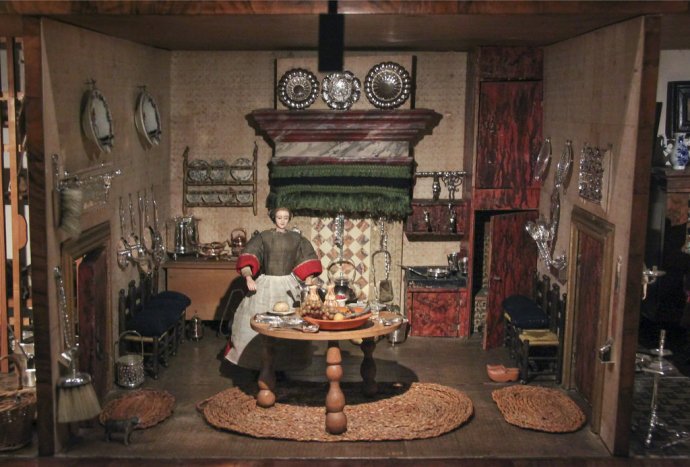
The doll’s house of Petronella Dunois (1650-1695), c. 1676, Rijksmuseum, Amsterdam, the Netherlands, inv.nr. BK-14656. Two shaving dishes are suspended on the left wall.
Chinese shaving bowls usually have the holes in the footring instead of the rim. Most Japanese barber’s bowls are more or less rounded, whereas Chinese barber’s bowls usually are oval (for a Chinese example, please see the 'Sold Archives' object 2011301)
Larger pieces of Japanese porcelain such as plates, bowls and dishes, had a tendency to ‘sag’ during firing. That’s why they were often supported in the kiln by small stoneware pillars. After firing, these small cones or spurs which adhered to the base were knocked off, leaving behind small unglazed rough patches or spur marks on the base. The supports were arranged in X, Y or other patterns. Whether they have any relevance to dating or an attribution to a specific kiln is still unresolved. These spur marks are typically Japanese and are rarely seen on Chinese porcelain.
Condition: Some wear to the decoration due to use.
References:
Arita 2000, p. 91, cat. 282, p. 152, p. 163 & p.233
Jörg 2003/1, p.14, pp.115-116, p.164, pp.184-185 & pp.200-201, cat 123, & cat. 256
Price: Sold.
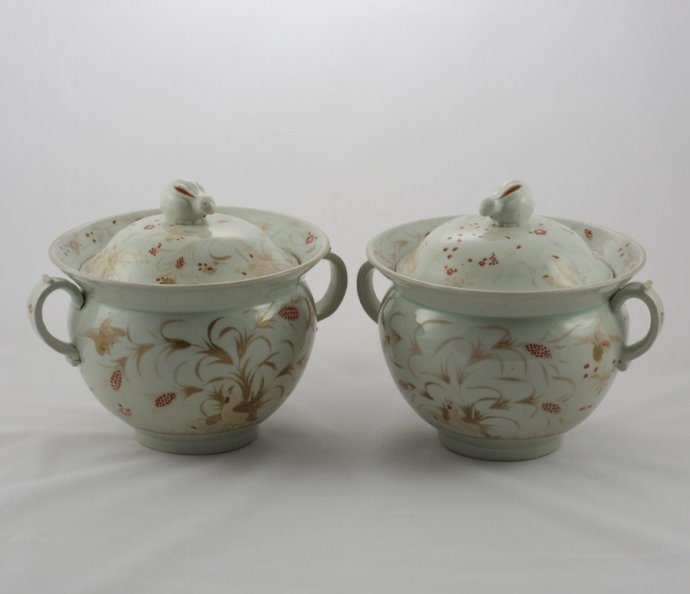
Sold Ceramics - Sold Japanese Imari 1690-1800 - 'Gold' Imari - Page 1
Objects 2011745 and 2011746
Two chamber-pots
Japan
1700-1720
2011745: Height with cover 245 mm (9.65 inch), height without cover 180 mm (7.09 inch), diameter of mouthrim 250 mm (9.84 inch), diameter of footring 102 mm (4.01 inch)
2011746: Height with cover 245 mm (9.65 inch), height without cover 182 mm (7.17 inch), diameter of mouthrim 248 mm (9.76 inch), diameter of footring 100 mm (3.94 inch)
Two chamber-pots on footrings with spreading upturned rims, each with two curved handles with thumb-rests. Domed recessed covers with finials modelled as a reclining hares. 'Gold' Imari, decorated in gold, iron-red and a pink-gold wash with three groups of flowering plants, each with a pair of birds, namely millet and quail, carnation and crested grouse and double camellia with partridge. Between each group a bird in flight. On the handle a floret between scrolls. The cover is decorated en suite, the hares have golden eyes and whiskers and iron-red ears.
Besides dinner services, covered jars, tea, coffee and chocolate sets, decorated in 'Gold' Imari with this design, also other utilitarian or luxury items, like these chamber-pots, were ordered after a Western model. These included cylindrical beer mugs, barbers' bowls, cuspidors and chamber-pots therefore this set can be considered Japon de commande objects. The production of chamber-pots as a non-fashionable utility-ware continued until the mid-18th century. (Jörg 2003/1, p.164, cat. 188)
The quail, closely allied to the partridge, is an emblem of courage both in China and Japan, as it is highly esteemed as a fighting bird. On Japanese porcelain they are frequently depicted amidst autumn grasses under millet. This quail and millet design, symbolizing the autumn is especially common on Kakiemon, but is also found on ko Kutani, Imari and blue-and-white wares. It has been suggested that that particular form is copied from the work of the painter Tosa Mitsuoki (1607-1691), but it probably originated from Chinese Paintings of the Sung period. This motif has been copied on European porcelain, especially at Bow and Chelsea where it is used as a decoration on the so-called 'partridge plates' and also on Meissen Porcelain. (Arts 1983, pp.134-135)
For identically decorated objects, please see:
- Japanese porcelain. A collector's guide to general aspects and decorative motifs, (P.L.W. Arts, De Tijdstroom, Lochem, 1983), pp.134-135, Plate 80.
- Imari-Porzellan am Hofe der Kaiserin Maria Theresia, exhibition catalogue (Hetjens-Museum, Düsseldorf, 2000), p.49, cat. 10.
- Japanese Export Porcelain. Catalogue of the Collection of the Ashmolean Museum, Oxford, (O. Impey, Hotei Publishing, Amsterdam, 2002), pp.249-250, cat. 443, 444 & 445.
- Fine & Curious. Japanese Export Porcelain in Dutch Collections, (C.J.A. Jörg, Hotei Publishing, Amsterdam, 2003), pp.115-1117, cat. 123 & 124, & p.201, cat. 256.
For identically shaped chamber-pots, please see:
- De Japanse Porseleinkast. Japans export porselein uit de 17e en 18e eeuw, exhibition catalogue Museum Willet-Holthuysen, Amsterdam 1972, p.15, cat.41.
- Jan Menze van Diepen Stichting. Selectie uit de collectie Oosterse keramiek (Jan Menze van Diepen Foundation. A Selection from the Collection of Oriental Ceramics), (C.J.A. Jörg, Jan Menze van Diepen Stichting / Jan Menze van Diepen Foundation, Slochteren 2002), p.191, cat. 132.
Condition:
2011745: Perfect.
2011746: Perfect with wear to the golden decoration.
References:
Arts 1983, pp.134-135 & Plate 80
Impey 2002, cat. 443, 444 & 445
Jörg 2003/1, cat. 123, 124 & 256
Price: Sold.
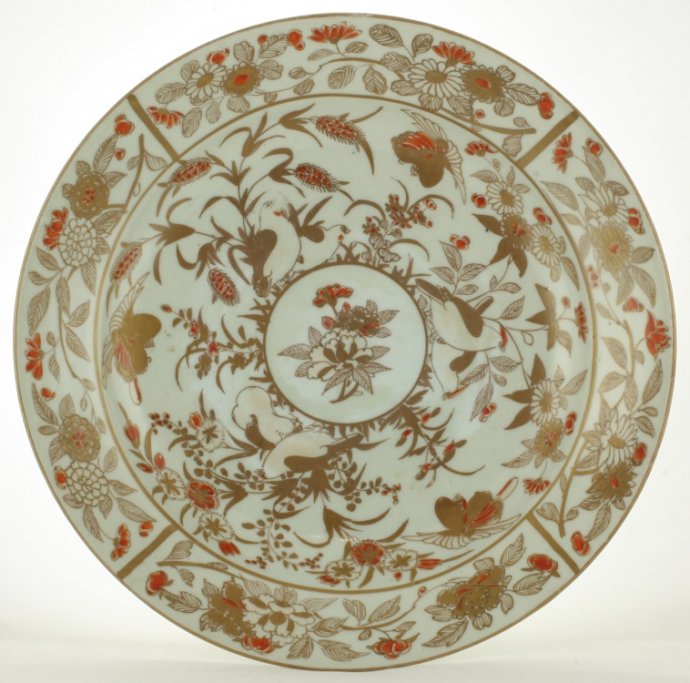
Sold Ceramics - Sold Japanese Imari 1690-1800 - 'Gold' Imari - Page 1
Object 2010574
Dish
Japan
1700-1720
Height 47 mm (1.85 inch), diameter of rim 295 mm (11.61 inch), diameter of footring 142 mm (5.59 inch)
Dish on footring, spreading flat rim. On the base four spur-marks in a Y-pattern. 'Gold' Imari, decorated in gold, iron-red and a light-pinkish gold wash with a spray of blossoming pomegranate in a central roundel surrounded by grasses and three groups of flowering plants each with a pair of birds, namely millet and quail, carnation and crested grouse, double camellia and partridge. In between each group a bird in flight. The rim with four panels containing sprays of peony, double magnolia, double chrysanthemum and double camellia. The reverse is undecorated.
These type of dishes are magnificent examples of the 'Gold' Imari group. No underglaze blue or other enamels are used, the light pinkish wash lending sufficient contrast to the brighter red and gold. This dish was once part of an extensive dinner set, now separated. In the collection of Oriental Ceramics of the Groninger Museum is an identically decorated teaset that consists of an identical teapot / hot water pot, six cups and saucers for tea or coffee, six chocolate cups with covers and saucers, a bowl with an overturned rim that might have been a sugar bowl and a ewer which may have been used as a milk jug but could also have been a condiment jug in a dinner set with the same design of which parts are also in the Groninger Museum. The set entered the Groninger Museum in 1899 as a bequest of the local collector, Mr. Mello Backer. Some sherds of similar wares have been excavated at Deshima. (Jörg 2003/1, p.201 & p.213)
For the identically decorated teaset in the collection of Oriental ceramics of the Groninger Museum, please see:
For an identically decorated dish, please see;
For a similarly decorated dish, please see;
Condition: Perfect.
References:
Jörg & Van Campen 1997, cat. 237
Jörg 2003/1, cat. 123, 124 & 256
Price: Sold.
More pictures of objects 2010573 another, identically sized, shaped and decorated, sold dish >>
More pictures of objects 2010575 another, identically sized, shaped and decorated, sold dish >>
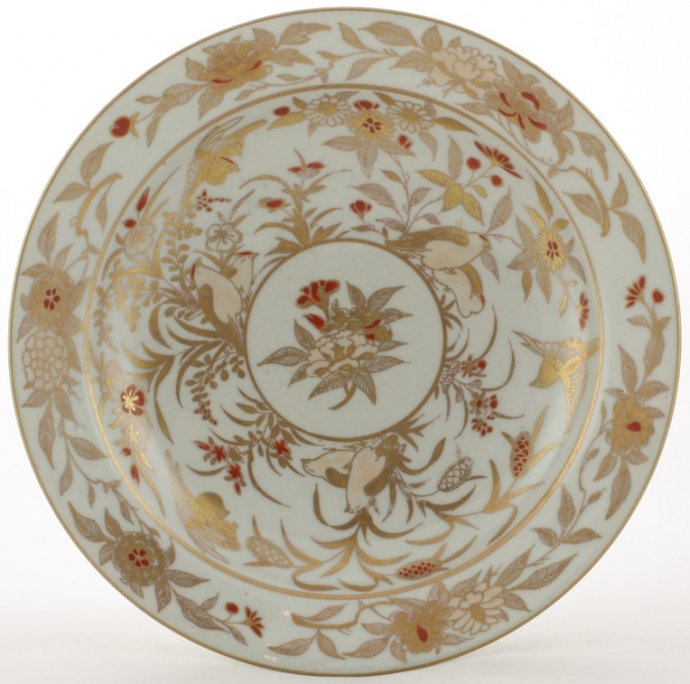
Sold Ceramics - Sold Japanese Imari 1690-1800 - 'Gold' Imari - Page 1
Object 2011444
Dish
Japan
1700-1720
Height 38 mm (1.49 inch), diameter of rim 211 mm (8.33 inch), diameter of footring 110 mm (4.33 inch), weight 371 grams (13.09 ounce (oz.))
Dish on footring, spreading flat rim. 'Gold' Imari, decorated in gold, iron-red and a light-pinkish gold wash with a spray of blossoming pomegranate in a central roundel surrounded by grasses and three groups of flowering plants each with a pair of birds, namely millet and quail, carnation and crested grouse, double camellia and partridge. In between each group a bird in flight. The rim with interlacing sprays of peony, double magnolia, and double camellia. The reverse is undecorated.
These type of dishes are magnificent examples of the 'gold' Imari group. No underglaze blue or other enamels are used, the light pinkish wash lending sufficient contrast to the brighter red and gold. This dish was once part of an extensive dinner set, now separated. In the collection of Oriental Ceramics of the Groninger Museum is an identically decorated teaset that consists of an identical teapot / hot water pot, six cups and saucers for tea or coffee, six chocolate cups with covers and saucers, a bowl with an overturned rim that might have been a sugar bowl and a ewer which may have been used as a milk jug but could also have been a condiment jug in a dinner set with the same design of which parts are also in the Groninger Museum. The set entered the Groninger Museum in 1899 as a bequest of the local collector, Mr. Mello Backer. Some sherds of similar wares have been excavated at Deshima. (Jörg 2003/1, p.201 & p.213)
For the identically decorated teaset in the collection of Oriental ceramics of the Groninger Museum, please see:
For identically decorated dishes, please see;
- The Voyage of Old-Imari Porcelains, (Kyushu Ceramic Museum, Arita 2000), pp.54..56, cat 81-85.
- Fine & Curious: Japanese Export Porcelain in Dutch Collections, (C.J.A. Jörg, Hotei Publishing, Amsterdam 2003), pp.115-116, cat. 123.
- Melk en Bloed. Exquisite porcelain from the Middle Kingdom, (D. Suebsman, Norden 2019), p.114, cat. 53.
For a similarly decorated dish, please see;
Condition: Perfect.
References:
Jörg & Van Campen 1997, cat. 237
Jörg 2003/1, cat. 123, 124 & 256
Price: Sold.
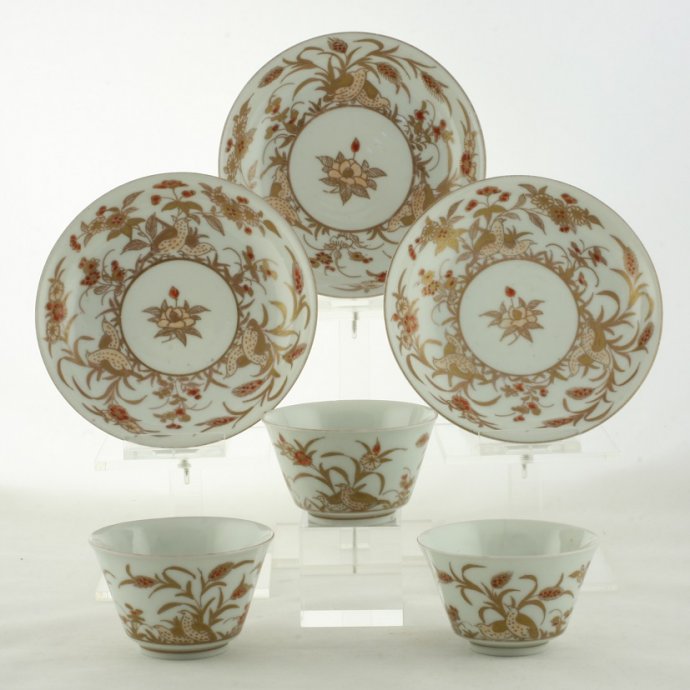
Sold Ceramics - Sold Japanese Imari 1690-1800 - 'Gold' Imari - Page 1
Objects 2011393, 2011417 & 2011418
Three teacups and saucers
Japan
1700-1720
Height of teacups 40 mm (1.57 inch), diameter of rims 67 mm (2.64 inch), diameter of footrings 33 mm (1.30 inch), weights 38/40/35 grams (1.34/1.41/1.23 ounce (oz.))
Height of saucers 25 mm (0.98 inch), diameter of rims 112 mm (4.41 inch), diameter of footrings 55 mm or (2.17 inch), weights 77/72/76 grams (2.72/2.54/2.68 ounce (oz.))
Three teacups and saucers on footrings, slightly everted rims. 'Gold' Imari, decorated in gold, iron-red and a light-pinkish gold wash with a single flowering peony in a central roundel surrounded by grasses and three groups of flowering plants namely; millet, carnation and camellia each with three groups of two partridges. On the bottom of the teacups a single flowering peony. The reverses of the saucers are undecorated.
The quail, or a pair of quails, fairly often used as a motif on fine porcelain, is a symbol of courage because of its fighting qualities. (Jörg & Van Campen 1997, p.213)
Condition:
Teacups: One with a frit and one with a hairline, both to the rim.
Saucers: All three perfect.
Reference:
Jörg & Van Campen 1997, cat. 237
Price: Sold.
More pictures object 2011393 >>
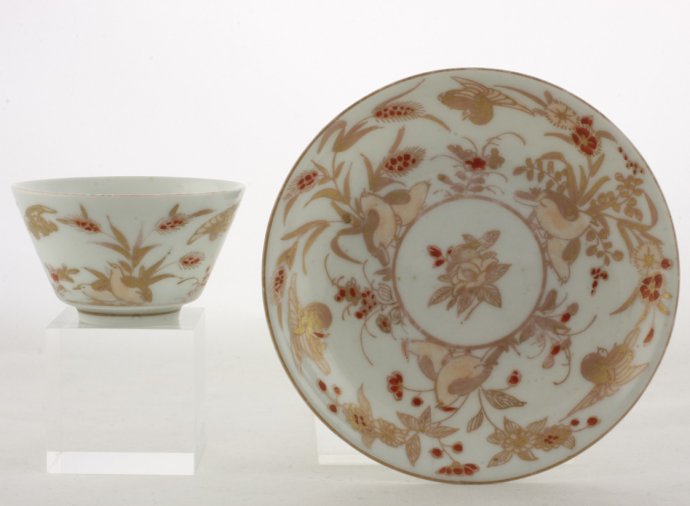
Sold Ceramics - Sold Japanese Imari 1690-1800 - 'Gold' Imari - Page 1
Object 2010673
Teacup and saucer
Japan
1700-1720
Height of teacup 38 mm (1.50 inch), diameter of rim 62 mm (2.56 inch), diameter of footring 25 mm (0.98 inch), weight 28 grams (0.99 ounce (oz.))
Height of saucer 20 mm (0.79 inch), diameter of rim 108 mm (4.25 inch), diameter of footring 51 mm or (2.01 inch), weight 50 grams (1.76 ounce (oz.))
Teacup and saucer on footrings, slightly everted rims. 'Gold' Imari, decorated in gold, iron-red and a light-pinkish gold wash with a single flowering peony in a central roundel surrounded by grasses and three groups of flowering plants namely; millet, carnation and camellia each with three groups of two partridges. In between each group a bird in flight. The teacup is decorated en suite.
In the collection of Oriental Ceramics of the Groninger Museum is a identically decorated teaset that consists of an identical teapot / hot water pot, six cups and saucers for tea or coffee, six chocolate cups with covers and saucers, a bowl with an overturned rim that might have been a sugar bowl and a ewer which may have been used as a milk jug but could also have been a condiment jug in a dinner set with the same design of which parts are also in the Groninger Museum. The set entered the Groninger Museum in 1899 as a bequest of the local collector, Mr. Mello Backer. Some sherds of similar wares have been excavated at Deshima. (Jörg 2003/1, p.201)
For an identically shaped, sized and decorated teacup and saucer, please see;
For the identically decorated teaset, in the collection of Oriental ceramics of the Groninger Museum, please see:
For an identically decorated bowl and chocolate cup with cover and saucer, please see;
Condition:
Teacup: Perfect, some wear to the decoration.
Saucer: A hairline to the rim.
References:
Jörg & Van Campen 1997, cat. 237
Price: Sold.


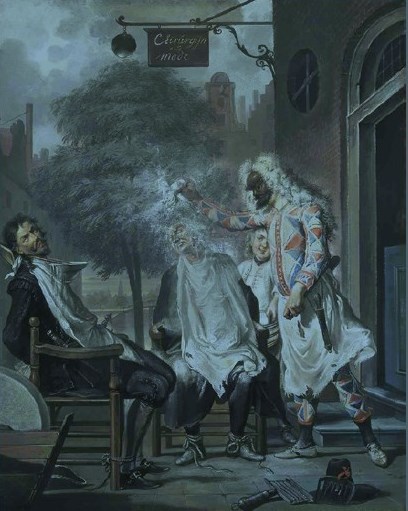
 create websites
create websites